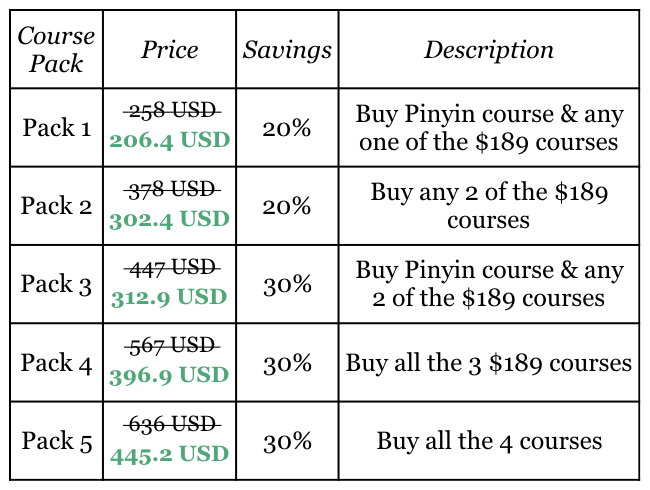Description
WHO IS THIS COURSE FOR?
- This course is for people who already have a basic command of Chinese.
- This course is for people who have already finished our Elementary Chinese Course (HSK Level 1).
- This course can be used to prepare for the test of HSK Level 2. It covers almost all the vocabulary and grammar points of the test of HSK Level 2.
- If you want to speak Chinese more confidently and better understand spoken Chinese, if you want to have a deeper knowledge of the structure of Chinese grammar, or if you simply want to take your Chinese to the next level, this course can help you achieve your goal.
- This course is perfect for people who plan to learn Chinese all by themselves or with limited time.
- It will also be a good complement for people who already attend a Chinese class.
- This course is not for the students who want to learn Chinese characters systematically, though Chinese characters are added with Pinyin together in this course.
HOW IT WORKS?
- Step 1: Watch a video lecture with detailed and clear explanations of how to use each of the vocabulary and grammar.
- Step 2: Listen to and read a realistic dialogue online, or download the audio and script to practice anytime, anywhere.
- Step 3: Take the online quiz to check your understanding about each lesson and consolidate what you have learned.
WHAT AM I GOING TO GET FROM THIS COURSE?
After working through this course, your Chinese level will be equal to the HSK Level 2. You will feel much more free to communicate in Chinese on common topics, such as talking about hobbies, asking for distance, ordering food, making a comparison, giving the reason, telling how you feel, inviting someone to hang out, asking for and giving advice, describing a person’s personality and appearance, making an appointment and expressing your concern, etc.
COURSE CONTENT
Lesson 21 (Please log in to view this sample lesson)
Lesson 22
- Asking a question politely
- How to say “Is A far away from B” in Chinese
- Talking about Metro lines and bus routes
- Expressing possibility with “可以(kěyǐ)”
- How to say “Is A close to B” and “A is next to B” in Chinese
- Emphasizing the distance is short with “就(jiù)”
Lesson 23
- Ordering food
- How to say “Would you like anything else” in Chinese
- How to say “Where do you want them delivered” in Chinese
- Telling an address
Lesson 24
- Explaining an experience with “Action verb + 过(guo)”
- The difference between “Action verb + 了(le)” and “Action verb + 过(guo)”
- Wishing someone a good time
- Expressing something is pleasant to do with “好(hǎo)”
Lesson 25
- Asking “Why” and giving the reason
- Telling how you feel physically
- The structure “多(duō) + Verb” and “少(shǎo) + Verb”
- “觉得(juéde)” as “to feel” & “to think”
- How to say “in that case”, “already” and “probably” in Chinese
Lesson 26
- The difference between “要(yào)” and “想(xiǎng)”
- Measure words for clothes and shoes
- Reduplication of verbs
- The difference between “有点儿(yǒudiǎnr) + Adj” and “Adj + 一点儿(yīdiǎnr)”
Lesson 27
- The four seasons of the year in Chinese
- How to form a superlative with “最(zuì)”
- Describing the weather and temperature
- The Chinese structure for “both…and…”
Lesson 28
- How to say “Happy birthday” in Chinese
- The Chinese word for “quick” and “quickly”
- Modifying nouns with “word + 的(de)” and “clause/phrase + 的(de)”
- Expressing a surmise with “吧(ba)”
- Expressing actions in progress
Lesson 29
- Expressing something is about to happen
- Expressing negative commands
- How to say “come in” and “go in” in Chinese
- How to say “at least” and “at most” in Chinese
Lesson 30
- The basic information about the HSK test
- The structure “Verb + 懂(dǒng)” and “Verb + 错(cuò)”
- The Chinese words for “all” and “most of”
- The Chinese structure for “if…then…”
Lesson 31
- Inviting people to hang out in Chinese
- Describing someone’s personality and appearance in Chinese
- Saying how long you did something for
- Using double “了(le)” to express ongoing duration
Lesson 32
- Telling why you want to look for a new job
- Different ways to find a new job
- How to ask someone to do something in Chinese
- The Chinese word for “oneself”
- How to say “Don’t be worried” and “Don’t be in a hurry” in Chinese
Lesson 33
- How to say “Good news” and “Congratulations” in Chinese
- How to say “come in” and “go in” in Chinese
- How to say “come back” and “go back” in Chinese
- Asking about someone’s availability in Chinese
- The difference between “见(jiàn)” and “见面(jiànmiàn)”
- The structure “太(tài) + adjective/verb + 了(le)”
Lesson 34
- Different Chinese words for “restaurant”
- The structure “更(gèng) + 喜欢(xǐhuan)”
- How to pay a bill in Chinese
- The structure “Verb + Result Complements”
- How to say “Wait a moment” in Chinese
Lesson 35
- Saying how much time you spend on your commute
- Talking about what people do on their commute
- The structure “这么(zhème) + adjective”
- The Chinese words that start or end with “上(shàng)”
- The difference between “上网(shàngwǎng)” and “网上(wǎng shàng)”
- The difference between “A 比(bǐ) B + adjective” & “更(gèng) + adjective”
Lesson 36
- How to address taxi driver in Chinese
- Another way to say “sorry” in Chinese
- How to say “A is close to B” in Chinese
- How to show directions in Chinese
- Telling a driver to park the car
Lesson 37
- Asking if someone has received your email
- Expressing different emotions with “啊(a)”
- The structure “再(zài) + verb”
- How to say “as soon as possible” in Chinese
- How to say “No wonder” in Chinese
Lesson 38
- The structure “越来越(yuèláiyuè) + adjective”
- Making suggestions in Chinese
- Chinese adverbs of frequency
- Making recommendations in Chinese
- The difference between “着急(zháojí)” and “担心(dānxīn)”
Lesson 39
- Making a comparison with “没有(méiyǒu)”
- Expressing that two things are the same or different in Chinese
- Expressing that two things are similar in Chinese
- Different meanings of “想(xiǎng)”
Lesson 40
- Saying an action is finished or will be finished in Chinese
- Asking what someone thinks of a movie or novel in Chinese
- Saying “borrow something from somebody/somewhere” in Chinese
- Saying “lend something to somebody”
- saying “return something to somebody/somewhere”


